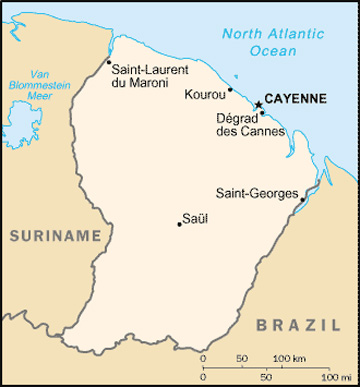Port of Call: Cayenne, French
Guyana
 By
Drake Nanda
By
Drake Nanda
Wanted for short-term occupancy
with an option to colonize: quaint, oceanfront property in the
equatorial region, new world. Should have multiship port with
navigable river access to interior. Prefer a native population of
savages for exploitation and forced labor, possible Christian
conversion, eventual extermination. Room for two major raw
materials, gold preferred. Contact: King of France, Paris.
This could have been the ad placed
by an acquisitive monarch set on snatching up a little slice of
South America back in the 16th century, known today as French Guyana
(or Guiana). All his friends and relatives were doing it, so why
miss out on the fun? It was actually a Spanish real estate agent
named Vincente Pinzón who first scouted the property in 1499, only
five years after Spain and Portugal divided the entire globe between
themselves by drawing a line of demarcation down the middle of the
Atlantic Ocean. Spain got everything west of the line and Portugal
took all territories to the east. Blind hubris though it was, it did
have a simple charm that can be appreciated in today’s complex
world. And had it actually worked, today we might be able to get a
decent paella in Jack London Square. Make that Juan Londres Plaza.
After five hundred years with the
property changing hands between European powers more often than a
time-share condo, the deed to this starter colony today rests firmly
with the Republic of France. And the shingle out front reads
"French Guyana-- just like France, only less so." To the
French government, this South American mangrove coast and jungle is
no different than Provence or the Rhone Valley. It is an
"Overseas Department of France" with one elected
representative to the National Assembly, chosen by voters thousands
of miles from Paris with French Francs and Euros in their pockets.
If it is difficult to imagine such a terribly anachronistic and
hauntingly colonial ministate owned outright in this day and age by
one of the modern world’s leading democratic nations, then think
of, well, Hawaii.
Cayenne is the peppery hot name of
the capital city and principle port, located on the northeast coast
of South America about 200 miles north of the mouth of the Amazon
River. All of its 48,000 residents are direct or indirect recipients
of approximately $500 million per year in subsidies from France. The
original idea was to subsidize the colony with human capital via the
off-shore penal system made famous by a pre-Laetrile Steve McQueen
in the movie Papillon. The offer made to France’s less
distinguished citizens went like this: do your time in a French
Guianese prison (a la Devil’s Island), then serve an equal amount
of time as a quasi-free indentured colonist farming the jungles. The
only problem was that the majority of prime candidates were dead
before they had a chance to make a positive contribution, aside from
fertilizer.
There is a different kind of
one-way port in the nearby city of Kourou, where the government has
decided on launching a geographically tangential activity to daily
life in French Guyana. This is the home of the European Space Centre,
where the community’s satellites are blasted into orbit at the
rate of about one every six weeks. And by the way, in case you are
thinking of anchoring your yacht near Devil’s Island to watch a
launch--ce n’est pas possible. The European Space Agency
forbids such suspicious activity. [Note to terrorists: shoot down
Arian rockets from the beach, not from the boat.] But why space
shots from here, of all places? It’s certainly not the
convenience. Or is it? It is actually more efficient to launch
space-bound rockets from locations closer to the earth’s equator,
thanks to centrifugal force. It takes about 30 percent more fuel to
get your baguettes into orbit from central France rather than from
the equator, which is very close to French Guyana. This means a
significant kilo-for-kilo increase in the amount of French cultural
influence circling the globe. Je suis content.
Cayenne, French Guyana— you can
get there from the San Francisco Bay in just 18 days traveling at 10
knots via the Panama Canal, a mere 4,471 miles away.
Port of Call is a regular
feature that takes a humorous historical look at ferry important
places around the globe each month, exclusively in Bay Crossings.
Tell us what you think-info@baycrossings.com.s